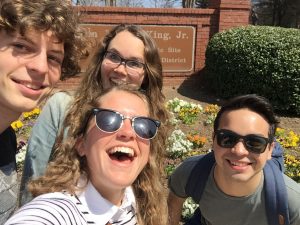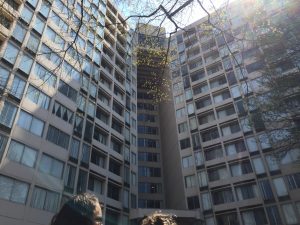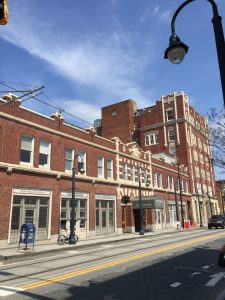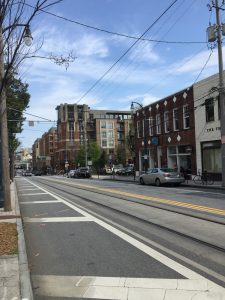
Arriving at Auburn Avenue
Auburn Avenue, a historically black neighborhood near Old Fourth Ward, is the site of more than 100 years of racial and socioeconomic change, and is now experiencing rapid gentrification. Once an overwhelmingly white neighborhood, Auburn Avenue saw the arrival of a few black families in the 1960’s, initiating the “white flight” to the suburbs and the development of a rich African American cultural center. Now, there is debate between making the neighborhood a “culturetainment” heritage center and preserving the neighborhood by preventing the displacement of the area’s residents .

Wheat Street Towers
The Wheat Street Towers, a retirement community along the eastern end of the avenue, are one example of original structures that provided housing for lower income locals. Adjacent to the Wheat Street Baptist Church, the elderly of the Towers often receive aid from the Church and have built strong relationships with the Church and the rest of the community. Various developers are looking to renovate the Towers, which would push the lower income residents out and continue the “reverse white flight.”

Graffiti addressing issues of Auburn Avenue and abandoned site
This empty lot along the street was the site of the Herndon Building. While only the brick stairs and foundation of the building remain, the racial and economic issues associated with the demolition are still seen in the graffiti on a nearby building. The saying “you can do anything if you try but can I live next door to you” directly addresses the transition of Auburn Avenue from a wealthy white neighborhood to an unstable black and white neighborhood to a black high-crime neighborhood. Within 10 years, this abandoned site will most likely be the location of a new high-rise apartment or shopping center full of small businesses.

Odd Fellows Building
The Odd Fellows building was one of the favorite spots for shopping and entertainment for the African American elite in the early 20th century. Now, the grandeur of the building is long gone, and broken windows and store fronts with lease signs indicate its deteriorated state. As Auburn Avenue continues to be gentrified, the Odd Fellows building could be the home of new stores and businesses that sell products that many of the current residents will not be able to afford.

End of Auburn Avenue closer to downtown
As you walk down Auburn Avenue towards downtown Atlanta, the buildings look increasingly well-maintained and the stores are full of patrons. Anyone walking through this part of the street could see these signs of economic growth as a good thing, a glimpse of the future of Auburn Avenue. However, what they don’t see is the displacement of hundreds of residents, mostly African American, due to the increase in home prices and retail space. While gentrification and the “reverse white flight” is improving the economic appeal of Atlanta, long-time locals are being forced out and the history of the neighborhood will soon be lost.